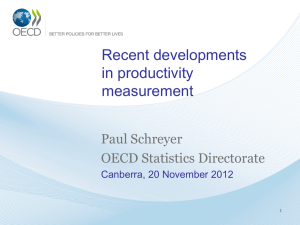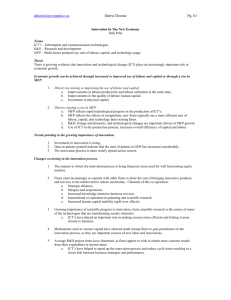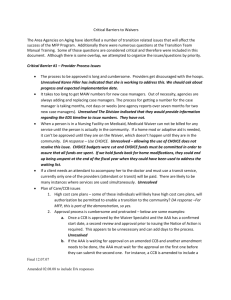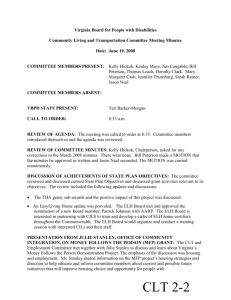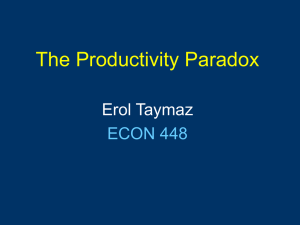An Economist's View of Costs
advertisement
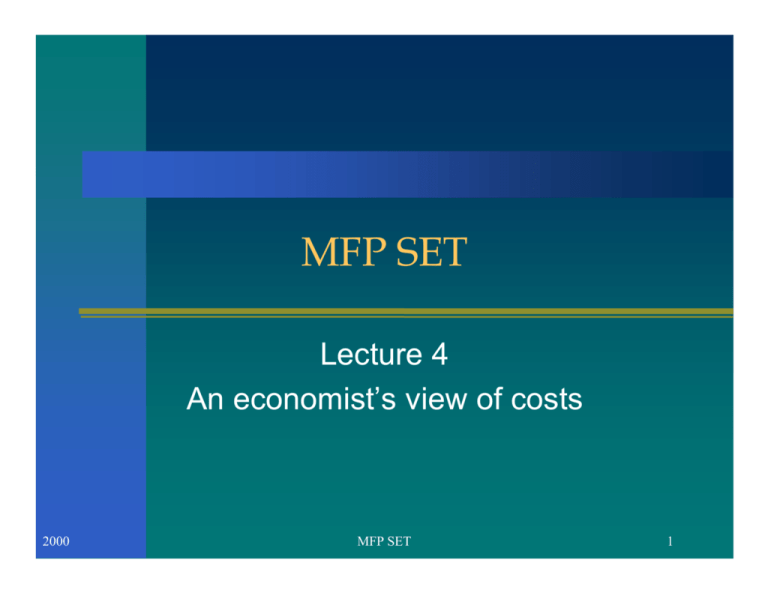
MFP SET Lecture 4 An economist’s view of costs 2000 MFP SET 1 Case studies 2000 ! Due in tutorials on Thursday, 9th March ! Odd numbered groups will turn in the assignment this week and be responsible for leading discussions in tutorials MFP SET 2 Tradeoffs ! Tradeoffs: the basis for opportunity costs ➢What do you have to give up to get something else ! 2000 The existence of tradeoffs are a measure of efficiency – if a firm faces tradeoffs, then it can’t produce more of one thing without giving up something else MFP SET 3 Efficiency ! Efficiency is the relationship between what an organisation produces & what it could feasibly produce ! Two reasons for inefficiency 1. Waste: X-inefficiency 2. Allocative inefficiency 2000 MFP SET 4 X-inefficiency 2000 ! Also called technical inefficiency: when more resources than required are used to produce a given quantity of output ! Indicates that more could be produced without giving up anything MFP SET 5 Allocative inefficiency ! Allocative inefficiency occurs when someone can be made better off without making someone worse off ➢Resources are allocated inefficiently when firms are producing goods that consumers don’t necessarily want ➢Can occur even if firms are producing those goods efficiently 2000 MFP SET 6 A diagrammatic view of inefficiencies ! ! X-inefficiency can be represented as being inside the production possibility frontier Allocative inefficiency is represented as being in the wrong place on the frontier Olympic venues X-inefficiency ! Hospitals 2000 MFP SET 7 Economic decision-making What is the process of economic decision-making? 1.Define your objectives – what is your goal? 2.List the options available 3.Choose the option that best meets your objective ! 2000 MFP SET 8 How to choose the appropriate option ! Using the logic of costs-benefits (what Maital refers to as cost-value logic), answer these questions ➢What am I giving up? ➢Is it worth more or less than I am gaining? ! 2000 A good choice matches costs - what am I giving up - with the value of what you gain MFP SET 9 Examples of tradeoffs To increase production, should we hire more labour or buy more capital equipment? Or smaller amounts of both? ! As an employer, do you want to provide more incentive for your employee, thus increasing his/her risk, or do you want to provide less risk, thus reducing incentives? ! 2000 MFP SET 10 Two sides to question ! Technology: what is the most efficient way to produce the product? ➢Depends on technology ➢Depends on input prices ! Preferences: what do consumers prefer? ➢Depends on tastes, income, location 2000 MFP SET 11 Comparative advantage ! Comparative advantage is the ability of one firm (country) to produce a good at a lower opportunity cost than another ➢Holds even if one produces all goods more cheaply ➢Relies on opportunity cost to determine which producer is lower cost ➢Is the reason why specialisation leads to greater consumption possibilities 2000 MFP SET 12 Two examples ! How should a relatively unproductive worker or plant or division be used, if at all? ! Should countries impose tariffs, quotas or other barriers to trade? ➢Why do most economists agree that free trade is optimal? 2000 MFP SET 13 An example ! Suppose that Australia & Japan both have 100 units of labour to devote to production of cars & wheat and that labour is the only input ➢Suppose that it takes 4 units of labour to produce a car in Australia, and 3 units of labour to produce a tonne of wheat ➢Suppose that it takes 1 unit of labour to produce a car in Japan, and 2 units of labour to produce a tonne of wheat 2000 MFP SET 14 Absolute advantage Given the numbers in the example, Japan is said to have an absolute advantage in the production of both goods – it can produce both goods at a lower absolute cost (using fewer resources) than Australia ! Does this mean that Australia should produce nothing? ! 2000 MFP SET 15 Using opportunity costs ! Consider Japan – in order to produce an additional car in Japan, 1/2 tonnes of wheat needs to be sacrificed ➢It takes 1 unit of labour to produce a car, and 2 units of labour to produce a tonne of wheat ! 2000 In order to produce an additional car, Australia must sacrifice 1 1/3 tonnes of wheat MFP SET 16 Opportunity costs Japan Cars Wheat 2000 1/2 tonne of wheat 2 cars MFP SET Australia 1 1/3 tonnes of wheat 3/ 4 cars 17 What does opportunity cost tell us? Cars are relatively inexpensive in Japan, while wheat is relatively expensive ! Wheat is relatively inexpensive in Australia, while cars are relatively expensive ! Conclusion: Australia should produce wheat, Japan should produce cars ! 2000 MFP SET 18 Production possibility frontiers Cars 100 Cars Japan Australia 25 50 2000 Wheat 33.3 MFP SET Wheat 19 Consumption prior to trade 2000 Japan Australia Total Cars 50 20 70 Wheat 25 6.67 31.67 MFP SET 20 Combined production possibilities Cars 125 Japan & Australia together 83.3 2000 MFP SET Wheat 21 Consumption possibilities Cars Japan & Australia together 125 100 70, 31.67 33.3 2000 MFP SET 83.3 Wheat 22 Consumption after specialisation & trade 2000 Japan Australia Cars 74 26 100 Wheat 26 7.3 33.3 MFP SET Total 23 Accountants vs economists ! Both want to provide managers with information about the cost of doing business to help them make decisions in the company’s best interest Accountants (usually) consider only explicit costs ! Economists also consider implicit costs ! 2000 MFP SET 24 Explicit and Implicit Costs ! A firm’s cost of production include explicit costs and implicit costs ➤Explicit costs involve a direct money outlay for factors of production ➤Implicit costs do not involve a direct money outlay 2000 MFP SET 25 Economic profit vs accounting profit Economists include all opportunity costs when measuring costs ! Accountants measure the explicit costs but often ignore the implicit costs ! 2000 MFP SET 26 Economic profit vs accounting profit ! When total revenue exceeds both explicit and implicit costs, the firm earns economic profit ➢Economic profit is smaller than accounting profit ➢Economists count a normal rate of return (the value of the next best use of the resource) as a cost 2000 MFP SET 27 A comparison of economic & accounting profit How an Economist Views a Firm Economic profit Revenue Implicit costs Explicit costs 2000 Total opportunity costs MFP SET 28 Economic Profit versus Accounting Profit How an Accountant Views a Firm How an Economist Views a Firm Economic profit Accounting profit Revenue Implicit costs Explicit costs 2000 Revenue Total opportunity costs MFP SET Explicit costs 29 Which costs are relevant? ! Two ways to determine relevant costs ➢Sunk vs incremental ➢Fixed vs variable Sunk costs: a prior expenditure that does not affect any current decision ! Incremental cost: a cost that is associated with any decision about a future course of action ! 2000 MFP SET 30 Fixed vs variable Fixed cost: a cost that does not change with the level of activity or output ! Variable cost: a cost that varies with the level of activity or output ! Sunk or fixed costs are irrelevant ! Incremental or variable costs are relevant ! 2000 MFP SET 31 Time ! Short run costs vs long run ➢In the short run, certain costs are fixed because certain factors of production are fixed ➢Examples: ✜ Capital equipment ✜ Labour? ✜ Leases on buildings 2000 MFP SET 32 Long run ! How long is the long run? ! How long does it take to vary all factors of production? ➢There are no fixed factors in the long run 2000 MFP SET 33 The production function The production function shows the relationship between quantity of inputs used to make a good and the quantity of output of that good ! The marginal product of any input into production is the increase in the quantity of output obtained from an additional unit of that input Additional output Marginal product = Additional input ! Diminishing marginal product ! Diminishing marginal product is the property that the marginal product of an input declines as the quantity of the input increases, holding other inputs constant ➢Example: As more and more workers are hired at a firm, each additional worker contributes less and less to production because the firm has a limited amount of equipment Marginal cost and marginal productivity ! Marginal cost rises with the amount of output produced ➢At low levels of output, an increase in production will occur at a relatively small cost ➢Increasing output is more costly when the amount being produced is already high – this is due to the existence of diminishing marginal productivity Marginal cost curves Costs $3.00 2.75 2.50 2.25 2.00 1.75 1.50 1.25 1.00 0.75 0.50 0.25 0 MC 1 2 3 4 5 6 7 8 9 10 11 12 13 14 Quantity of Output (bagels per hour) Definitions of cost concepts Total cost: ! Average fixed cost: ! Average variable cost: ! Average total cost: ! ! 2000 *Marginal cost: MFP SET TC = TFC + TVC AFC = TFC/Q AVC = TVC/Q ATC = TC/Q = AFC + AVC MC = ∆TVC/ ∆Q = ∆TVC/ ∆Q 38 Average cost curves Costs $3.00 2.75 2.50 2.25 2.00 1.75 1.50 1.25 1.00 0.75 0.50 0.25 0 ATC AVC AFC 1 2 3 4 5 6 7 8 9 10 11 12 13 14 Quantity of Output (bagels per hour) Relationship between marginal cost and average total cost Costs $3.00 2.75 2.50 2.25 2.00 1.75 1.50 1.25 1.00 0.75 0.50 0.25 0 MC ATC 1 2 3 4 5 6 7 8 9 10 11 12 13 14 Quantity of Output (bagels per hour)

